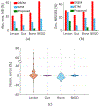A Projection-Domain Low-Count Quantitative SPECT Method for α-Particle-Emitting Radiopharmaceutical Therapy
- PMID: 37201111
- PMCID: PMC10191330
- DOI: 10.1109/trpms.2022.3175435
A Projection-Domain Low-Count Quantitative SPECT Method for α-Particle-Emitting Radiopharmaceutical Therapy
Abstract
Single-photon emission-computed tomography (SPECT) provides a mechanism to estimate regional isotope uptake in lesions and at-risk organs after administration of α-particle-emitting radiopharmaceutical therapies (α-RPTs). However, this estimation task is challenging due to the complex emission spectra, the very low number of detected counts (~20 times lower than in conventional SPECT), the impact of stray-radiation-related noise at these low counts, and the multiple image-degrading processes in SPECT. The conventional reconstruction-based quantification methods are observed to be erroneous for α-RPT SPECT. To address these challenges, we developed a low-count quantitative SPECT (LC-QSPECT) method that directly estimates the regional activity uptake from the projection data (obviating the reconstruction step), compensates for stray-radiation-related noise, and accounts for the radioisotope and SPECT physics, including the isotope spectra, scatter, attenuation, and collimator-detector response, using a Monte Carlo-based approach. The method was validated in the context of 3-D SPECT with 223Ra, a commonly used radionuclide for α-RPT. Validation was performed using both realistic simulation studies, including a virtual clinical trial, and synthetic and 3-D-printed anthropomorphic physical-phantom studies. Across all studies, the LC-QSPECT method yielded reliable regional-uptake estimates and outperformed the conventional ordered subset expectation-maximization (OSEM)-based reconstruction and geometric transfer matrix (GTM)-based post-reconstruction partial-volume compensation methods. Furthermore, the method yielded reliable uptake across different lesion sizes, contrasts, and different levels of intralesion heterogeneity. Additionally, the variance of the estimated uptake approached the Cramér-Rao bound-defined theoretical limit. In conclusion, the proposed LC-QSPECT method demonstrated the ability to perform reliable quantification for α-RPT SPECT.
Keywords: Radium-223; low counts; quantitative single-photon emission-computed tomography (SPECT); regional quantification; α-particle therapies.
Figures











Similar articles
-
ISIT-QA: In Silico Imaging Trial to Evaluate a Low-Count Quantitative SPECT Method Across Multiple Scanner-Collimator Configurations for 223Ra-Based Radiopharmaceutical Therapies.J Nucl Med. 2024 May 1;65(5):810-817. doi: 10.2967/jnumed.123.266719. J Nucl Med. 2024. PMID: 38575187 Free PMC article.
-
WIN-PDQ: A Wiener-estimator-based projection-domain quantitative SPECT method that accounts for intra-regional uptake heterogeneity.Proc SPIE Int Soc Opt Eng. 2024 Feb;12925:1292512. doi: 10.1117/12.3006569. Epub 2024 Apr 1. Proc SPIE Int Soc Opt Eng. 2024. PMID: 40708611 Free PMC article.
-
WIN-PDQ: A Wiener-estimator-based projection-domain quantitative SPECT method that accounts for intra-regional uptake heterogeneity.ArXiv [Preprint]. 2024 Mar 25:arXiv:2403.17226v1. ArXiv. 2024. Update in: Proc SPIE Int Soc Opt Eng. 2024 Feb;12925:1292512. doi: 10.1117/12.3006569. PMID: 38584616 Free PMC article. Updated. Preprint.
-
Joint regional uptake quantification of Thorium-227 and Radium-223 using a multiple-energy-window projection-domain quantitative SPECT method.ArXiv [Preprint]. 2024 Jul 1:arXiv:2305.17117v4. ArXiv. 2024. Update in: IEEE Trans Med Imaging. 2024 Dec;43(12):4281-4293. doi: 10.1109/TMI.2024.3420228. PMID: 37292467 Free PMC article. Updated. Preprint.
-
The AAPM/RSNA physics tutorial for residents. Physics of SPECT.Radiographics. 1996 Jan;16(1):173-83. doi: 10.1148/radiographics.16.1.173. Radiographics. 1996. PMID: 10946698 Review.
Cited by
-
ISIT-QA: In Silico Imaging Trial to Evaluate a Low-Count Quantitative SPECT Method Across Multiple Scanner-Collimator Configurations for 223Ra-Based Radiopharmaceutical Therapies.J Nucl Med. 2024 May 1;65(5):810-817. doi: 10.2967/jnumed.123.266719. J Nucl Med. 2024. PMID: 38575187 Free PMC article.
-
A tissue-fraction estimation-based segmentation method for quantitative dopamine transporter SPECT.Med Phys. 2022 Aug;49(8):5121-5137. doi: 10.1002/mp.15778. Epub 2022 Jun 29. Med Phys. 2022. PMID: 35635327 Free PMC article.
-
A list-mode multi-energy window low-count SPECT reconstruction method for isotopes with multiple emission peaks.EJNMMI Phys. 2023 Jun 22;10(1):40. doi: 10.1186/s40658-023-00558-3. EJNMMI Phys. 2023. PMID: 37347319 Free PMC article.
-
Nuclear Medicine and Artificial Intelligence: Best Practices for Evaluation (the RELAINCE Guidelines).J Nucl Med. 2022 Sep;63(9):1288-1299. doi: 10.2967/jnumed.121.263239. Epub 2022 May 26. J Nucl Med. 2022. PMID: 35618476 Free PMC article.
-
No-gold-standard evaluation of quantitative imaging methods in the presence of correlated noise.Proc SPIE Int Soc Opt Eng. 2022 Feb-Mar;12035:120350M. doi: 10.1117/12.2605762. Epub 2022 Apr 4. Proc SPIE Int Soc Opt Eng. 2022. PMID: 36465994 Free PMC article.
References
-
- Kluetz PG et al., “Radium Ra 223 dichloride injection: U.S. Food and Drug Administration drug approval summary,” Clin. Cancer Res, vol. 20, no. 1, pp. 9–14, 2014. - PubMed
-
- Kratochwil C et al., “Targeted α-therapy of metastatic castration-resistant prostate cancer with 225Ac-PSMA-617: Dosimetry estimate and empiric dose finding,” J. Nucl. Med, vol. 58, no. 10, pp. 1624–1631, 2017. - PubMed
-
- Jurcic JG et al., “Targeted α particle immunotherapy for myeloid leukemia,” Blood, vol. 100, no. 4, pp. 1233–1239, 2002. - PubMed
Grants and funding
LinkOut - more resources
Full Text Sources
